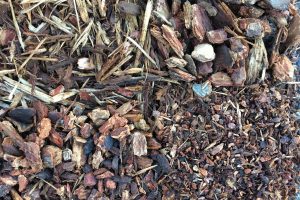
Choose young trees wisely—avoid trees with poor structure and included bark.
As a landscaper and UCCE Master Gardener, I have encountered many poorly shaped and suffering young trees. There are, however, a few simple guidelines on selecting and staking that will help your tree achieve a long and lovely life.
Many people select the tree with the most foliage, but what is far more important are girth and trunk straightness. Ideally, you want to choose a tree that will not need staking to hold it upright.
Another thing to assess is branch structure. The goal is to select a tree with a strong central trunk and sturdy, well-spaced branches – the scaffolding of the tree. Bushy foliage is not always a good thing, especially with a weak trunk. Multiple, competing central leaders and crossing branches will eventually need to be pruned off, so make sure you begin with a good trunk and promising scaffold branches.

Keep in mind that tree branches don’t grow vertically; they retain their original height on the trunk. Don’t prune the lower branches during the first couple of seasons; young trees need plenty of leaves for photosynthesis and growth.
When you plant your new tree, remove any nursery stakes. They are installed for nursery convenience and not for the benefit of the tree. The stakes constrict the flow of nutrients in outer bark layers. Don’t stake at all unless absolutely necessary. Young trees need to bend a little in the wind for proper root and girth development. However, if your new tree is not strong enough to hold the top upright or to return upright after being bent, then staking is a good idea for the first year or two.

The most common tree-staking mistake is to leave the nursery stake attached, which can strangulate it.
Support staking is usually not required for conifers or other trees that branch close to the ground. Staking is not a requirement for most potted orchard trees because they are often lopped off at two or three feet from the ground to encourage an open, vase-like structure. The low branches enable easier picking and the ability to remain upright without support.
Proper staking of a landscape tree requires two stakes. While three stakes are advantageous in some situations, two are generally sufficient. Place them outside the root ball on opposite sides of the tree, perpendicular to the prevailing wind. Remember to remove the nursery stake!

Properly staked tree with two stakes.
Use rubbery support ties placed as low as possible on the trunk yet high enough to return the tree upright after deflection. In windy areas, the ties may need to be higher to prevent the canopy from breaking off. Screw the ties in place on the stakes to prevent slippage. Remember that the top of the tree needs to bend in the wind to encourage stronger root growth.
Cut off excess stake height a few inches above the ties to avoid branch injury. Remove the stakes when the tree is able to stand upright on its own, usually within one year.
Janice Moody has been a UC Master Gardener since 2010 and is the owner of Seascape Succulents in downtown Half Moon Bay. The article was edited by Susan Kornfeld and Cynthia Nations, UCCE Master Gardeners and published in Half Moon Bay Magazine, May 2019 issue.





Leave a Reply
Your email is safe with us.